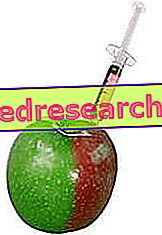Not just dairy products
Vegetables are a precious source of calcium, second in importance only to dairy products. Among the most rich in calcium vegetables we remember the agretti, the green leafy vegetables (Catalonian chicory, turnip greens, rocket and lettuce), broccoli, celery from the coast, fennel, cabbage and leeks. Sage, with its 600 mg of calcium per 100 grams, represents one of the richest plants of this element; c

The importance of calcium-rich vegetables in the diet is particularly relevant in the diet of lactose intolerant people. These individuals, given the lack of lactase, are in fact forced to more or less drastically remove lactose-rich foods from their diet. As a result, depriving themselves of milk and dairy products (although yogurt and hard cheeses are generally well tolerated), in the long run it is possible to develop calcium deficiencies. The same applies to strict vegetarians (vegans).
Bioavailability of calcium in vegetables
In general, calcium present in vegetables is considered to be much less available than that contained in milk and dairy products. This assumption derives from the presence of anti-nutritional factors such as phytic acid and oxalates, which limit the absorption of calcium by forming insoluble compounds. Foods particularly rich in phytates and oxalates are bran, spinach, rhubarb and tomatoes.
Apart from oxalic acid and phytic acid, it must be considered that the calcium present in vegetables is highly bioavailable, because it is found together with synergistic minerals (in this study, for example, it is shown how the cabbage calcium is absorbed in percentages even higher than in that of milk). In cheeses and dairy products, on the other hand, in addition to calcium, we find important amounts of phosphorus, which at high doses (for example due to the addition of polyphosphates in melted cheeses) can limit their absorption. On this scientific basis rests the eternal struggle between vegans, firm supporters of the thesis according to which the calcium of vegetable origin would be much more available than the animal one, and the supporters of an omnivorous diet, according to which milk and derivatives represent the most precious source of calcium available in nature. Simply, to improve absorption, protein excesses should be avoided, consuming at least 5-6 servings of vegetables per day. Even the salt should be severely limited, as is alcohol. On the other hand, we cannot forget that a small glass of skimmed milk and a jar of yogurt provide about 150 mg of calcium each, while 5 teaspoons of grated Grana Padano cheese (25 g) add up to 300 mg.
Calcium content in vegetables
| vegetable | Amount of Calcium per 100 grams of food | |
| Savory | 2132 | mg |
| Dried basil | 2113 | mg |
| Marjoram, dried | 1990 | mg |
| Dried thyme | 1890 | mg |
| Celery seeds | 1767 | mg |
| Sage, fresh | 1652 | mg |
| Origan | 1597 | mg |
| Dried mint | 1488 | mg |
| Dry rosemary | 1280 | mg |
| Tarragon | 1139 | mg |
| Sesame | 975 | mg |
| Cumin seeds | 931 | mg |
| Laurel | 834 | mg |
| Coriander Seeds | 709 | mg |
| Cumin | 689 | mg |
| Pimento | 661 | mg |
| Aniseed | 646 | mg |
| Cloves | 646 | mg |
| Fresh thyme | 405 | mg |
| Cardamom | 383 | mg |
| Fresh rosemary | 317 | mg |
| Chili powder | 278 | mg |
| Mustard seeds | 266 | mg |
| White pepper | 265 | mg |
| Fresh peppermint | 243 | mg |
| Dehydrated carrots | 212 | mg |
| Dill | 208 | mg |
| Fresh mint | 199 | mg |
| Garlic | 181 | mg |
| Basil | 177 | mg |
| Tomato powder | 166 | mg |
| Dried figs | 162 | mg |
| Rocket salad | 160 | mg |
| Spinach, frozen, boiled | 153 | mg |
| Cannellini beans | 147 | mg |
| Parsley | 138 | mg |
| Fresh borlotti beans | 127 | mg |
| Beet | 117 | mg |
| Black olives | 109 | mg |
| Turnip broccoli | 108 | mg |
| Chickpeas | 105 | mg |
| Cutting chicory | 100 | mg |
| spinach | 99 | mg |
| Borage | 93 | mg |
| Chives | ninety two | mg |
| Rhubarb | 86 | mg |
| Watercress | 81 | mg |



